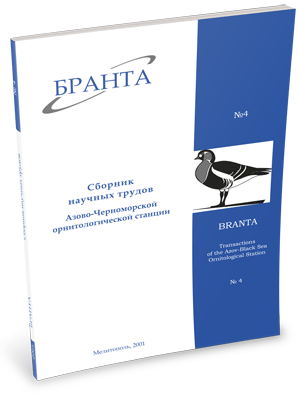
Transactions
of the Azov-Black Sea Ornithological Station



Numbers and distribution of waterfowls in the Stensovsko-Zhebriyansky Plavni of the Danube River in 2001.
Koshelev A.I., Koshelev V.A., Zhmud M.E., Pokusa R.V., Chichkin V.N., Fedorenko A.V.
In April-July, 2001 we have done 3 expeditions on the territory of Stensovsko-Zhebriyansky Plavni (SZP) (Danube Biosphere Reserve, Vilkovo). There were done 45 counts, 15 plots were surveyed. More than 80000 waterbirds of 92 species, including 36000 individuals of waterfowls were counted. We have examined 205 nests and 173 clutches, there were counted 529 broods with nestlings of different age. 22 places of moulting river ducks and coots were found and surveyed. Dominant species of them were Coot, Moorhen, Mallard, Pochard, Mute Swan. Red-crested Pochard (410 pairs) and Ferruginous Duck (365 pairs) had a high number of populations. It testifies about proceeding restoration of their population on that territory. The most valuable sites of Stensovsko-Zhebriyansky Plavni for nesting of waterfowls in 2001 were Grabovskiy liman, Bolshoy Solyonyi liman, Shyrokaya Channel, Glukhaya Channel, and a system of river reaches near the hunting house. Dominant nesting species of waterfowls in Plavni in 2001 were Coot (3100 pairs), Mallard (1299 pairs), Pochard (1430pairs). The total number of 15 species was 11,907 nesting pairs.
Males were prevailed among river ducks at the end of spring. Correlation between females and males for Mallard was -1:25, for Garganey - 1:2, for Pochard -1:2, for Ferruginous Duck -1:1.3. The average size of clutches for Mallard was 9.12 of eggs, for Pochard - 8.82 of eggs, for Ferruginous Duck -8.10 of eggs, for Red-crested Pochard - 8.78 of eggs, for Coot - 7.66 of eggs. Pochard had 31.2% mixed cluthces with the eggs of females of different species of ducks, Red-crested Pochard had 50%, Ferruginous Duck - 34.7%.
Mute Swan had the maximum of breeding success (95%), Coot had 85%, Mallard - 65%, Red-crested Pochard - 45%, Black-necked Grebe - 40%. The size of broods with nestlings was: 4.5 for Mute Swan, 5.23 for Pochard, 5.41 of nestlings for Coot.
Destruction of clutches was 27-35% for ducks, 29% for Cool. The most favourable for nesting of waterfowls was the bush type of reed growth, where the density of mass species nesting achieved 10.0-33 nests per hectare. In the colonies of Ardeidae and Laridae the nesting density reached 116-206 nests per hectare. For improving nesting conditions of waterfowls in Stensovsko-Zhebriyansky Plavni it is necessary to undertake the following organizational and biotechnical actions: to increase the mosaic of nested sites up to 50-60% of overgrowning; to support a high steady level of water in plavni; to make clearing of existing channels, canals, and river reaches; to expand their network, to renew work on construction and installation of artificial nests for waterfowls; to strengthen the struggle against four-legged and feathery predators; to limit and regulate the grazing of cattle on the coasts of Stensovsko-Zhebriyansky Plavni; for Greylag Goose - to restore the coastal meadows in some sites of Plavni, which are important for feeding of non-flying broods and also to defer an opening of summer and autumn hunting season for the gamebird.
Read the paper in a PDF file